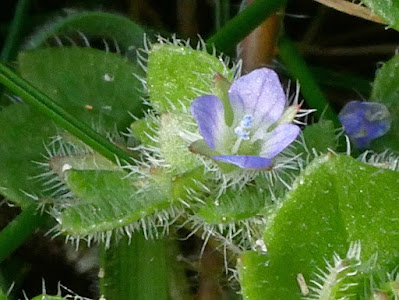In a similar vein to 2022, it seems that Winter dragged on forever. Just when the weather turned mild and Spring plants began to appear, we had a prolonged cold spell in early March with some snow on higher ground, putting the plants back yet again.
However, we have now had a week of Atlantic air flow bringing wind, rain and above average temperatures to the peninsular and the flowers are now responding. The following plants are some of the more interesting plants of the season I've found so far, though I have included some Spring favourites too.
****
Springtime is the time for bulbs, from Daffodils to Snowdrops and a plethora of garden escapes like the one below. Summer Snowflake, so named because it was named in Sweden where these flower much later than in the UK. Whilst the flowers are attractive, you have to get underneath them to see the insides, so expect muddy knees when taking a photograph. I found these in flower at the end of February on a rural roadside verge.
Leucojum aestivum subsp pulchellum - Summer Snowflake
I'd never seen this type of plant before, though I quickly recognised it as a Geranium. Research and help from other botanists narrowed this down to be Rock Cranesbill, a garden escape growing wild.
Geranium macrorrhizum - Rock Cranesbill
Dandelion season is now upon us, when the fresh Spring grown leaves aid identification of this difficult group. A little known fact is that there are around 250 species of Dandelion in the UK alone. Nearly all of them produce clones and do not hybridise. It's called an apomictic species, with each group of plants mutating over time to form a different species. Brambles and Hawkweeds are similar in being apomictic.
The Dandelion below keyed out to be Taraxacum prionum, however, the BSBI referee couldn't be absolutely certain due to the leaves not being mature enough. If I find time, I''ll go back and have another look.
Asplenium obovatum subsp lanceolatum - Lanceolate Spleenwort
This is one of the problems of botany in early Spring. Sometimes it's not possible to firmly say what a plant you've found is called. Still, I would rather look than stay indoors.
After searching out various Erica species last year, I realised there was one I had missed by referring to the amazinf Flora of Cornwall book that I own. It was Portuguese Heath, a naturalised garden escape that is infrequently found around the county. I had earmarked a site near Lanhydrock to go and see one, but I found the ones below first, saving me a visit. These were widespread around the cliffs at the back of Carlyon Bay near St. Austell and put on quite a show. I saw more by the side of the A391 climbing out of St Austell too. I'd not seen this species before, so they were nice finds for me.
I quite like Fumitories, although they can be challenging to sort to species and sub species levels. The most common here is Common Ramping Fumitory and it's just coming back into flower now in numbers. It's quite a large Fumitory with flowers around 12mm long, the top and side petals are black tipped and moderate sized sepals with ragged edges around the base area.
Fumaria muralis - Common Ramping Fumitory
My final plant highlighted for early Spring is the Sweet Violet. It's a lovely plant and comes in various colour forms, the usual being a deep purple. So it is always nice to find the variants and below is a white form. There are actually two white forms, one with tufts of hairs on the side petals like this one below and one without (var. imberbis).
Viola odorata var. dumetorum - Sweet Violet
I hope you enjoyed the first blog of 2023 from me. Of course, I omitted lots of wildflowers coming out now, such as carpets of Lesser Celandines, Primroses and Greater Stichworts, all beginning to light up the road verges here in Cornwall. It's a similar story around the southern part of the UK so go out for a walk and see what you can find. Most of all, have fun looking and enjoy yourself.
Take care
Dave
@Botany2021 (Twitter)




.jpg)





















No comments:
Post a Comment
All comments are moderated before publication, so please don't bother spamming me, thank you. Genuine comments most welcome.